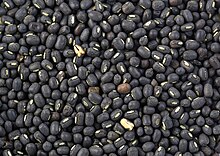Vigna mungo
| Vigna mungo | |
|---|---|
 |
|
| Dry urad beans | |
| Scientific classification | |
| Kingdom: | Plantae |
| (unranked): | Angiosperms |
| (unranked): | Eudicots |
| (unranked): | Rosids |
| Order: | Fabales |
| Family: | Fabaceae |
| Subfamily: | Faboideae |
| Tribe: | Phaseoleae |
| Genus: | Vigna |
| Species: | Vigna mungo |
| Binomial name | |
|
Vigna mungo (L.) Hepper |
|
| Synonyms | |
|
|
| Nutritional value per 100 g (3.5 oz) | |
|---|---|
|
58.99
|
|
| Sugars | 0 |
| Dietary fiber | 18.3 |
|
1.64 g
|
|
|
25.21
|
|
| Vitamins | |
| Thiamine (B1) |
(24%)
0.273 mg |
| Riboflavin (B2) |
(21%)
0.254 mg |
| Niacin (B3) |
(10%)
1.447 mg |
| Pantothenic acid (B5) |
(0%)
0.0 mg |
| Vitamin B6 |
(22%)
0.281 mg |
| Folate (B9) |
(54%)
216 μg |
| Choline |
(0%)
0 mg |
| Vitamin C |
(0%)
0 mg |
| Vitamin E |
(0%)
0 mg |
| Vitamin K |
(0%)
0 μg |
| Minerals | |
| Calcium |
(14%)
138 mg |
| Iron |
(58%)
7.57 mg |
| Magnesium |
(75%)
267 mg |
| Manganese |
(0%)
0 mg |
| Phosphorus |
(54%)
379 mg |
| Potassium |
(21%)
983 mg |
| Sodium |
(3%)
38 mg |
| Zinc |
(35%)
3.35 mg |
| Other constituents | |
| Water | 10.8 |
|
|
|
|
|
| Percentages are roughly approximated using US recommendations for adults. Source: USDA Nutrient Database |
|
Vigna mungo, black gram, black lentil, mungo bean (not to be confused with the much smaller true black lentil (Lens culinaris)), black matpe bean, Sanskrit माष / māṣa, is a bean grown in the Indian subcontinent. At one time it was considered to belong to the same species as the mung bean.
The product sold as black lentils is usually the whole urad bean, whereas the split bean (the interior being white) is called Ulunthu in Tamil, Minumulu in Telugu,"'uddinabēḷe"' in Kannada, Urad Dal in Hindi, or white lentils.
Black gram originated in India, where it has been in cultivation from ancient times and is one of the most highly prized pulses of India and Pakistan. The coastal Andhra region in Andhra Pradesh is famous for black gram after paddy. The Guntur District ranks first in Andhra Pradesh for the production of black gram. Black gram has also been introduced to other tropical areas mainly by Indian immigrants.
It is an erect, suberect or trailing, densely hairy, annual herb. The tap root produces a branched root system with smooth, rounded nodules. The pods are narrow, cylindrical and up to six cm long. The plant grows 30–100 cm with large hairy leaves and 4–6 cm seed pods. While the urad bean was, along with the mung bean, originally placed in Phaseolus, it has since been transferred to Vigna.
Vigna mungo is popular in India, largely used to make dal from the whole or split, dehusked seeds. The bean is boiled and eaten whole or, after splitting, made into dal; prepared like this it has an unusual mucilaginous texture. It is also extensively used in South Indian culinary preparations. Urad Dal is one of the key ingredient in making the Idli-Dosa batter, where one part of Urad Dal is mixed with Three or Four parts of Idli Rice to make the batter. Also the dough for Vada or Udid Vada is made from soaked batter and deep fried in cooking oil. The dough is also used in making Papad, notably the South Indian version known as Appalam and Papadum, in which white lentils are usually used.
...
Wikipedia
